Good day,
Python-pptx allows me to fill table cell with a color, or allows to have that cell's borders with parametrized width and color. However I can not do both, since after the fill borders disappear. I wonder how to properly combine these actions.
The desired output could look like first table from documentation: https://python-pptx.readthedocs.io/en/latest/user/table.html (the default color is blue, and this one is gray, with borders)
Minimal reproducible example:
from pptx import Presentation
from pptx.util import Cm
from pptx.oxml.xmlchemy import OxmlElement
from pptx.dml.color import ColorFormat, RGBColor
ppt = Presentation()
s1 = ppt.slide_layouts[6]
slide = ppt.slides.add_slide(s1)
rows = 3
columns = 2
shape = slide.shapes.add_table(rows, columns, left=Cm(1), top=Cm(1), width=Cm(10), height=Cm(10))
table = shape.table
table.first_row = False
#-----------------------------------------------------------------------------------------
#https://stackoverflow.com/questions/42610829/python-pptx-changing-table-style-or-adding-borders-to-cells
def SubElement(parent, tagname, **kwargs):
element = OxmlElement(tagname)
element.attrib.update(kwargs)
parent.append(element)
return element
def _set_cell_border(cell, border_color="000000", border_width='12700'):
tc = cell._tc
tcPr = tc.get_or_add_tcPr()
for lines in ['a:lnR','a:lnB']:#['a:lnL','a:lnR','a:lnT','a:lnB']:
ln = SubElement(tcPr, lines, w=border_width, cap='flat', cmpd='sng', algn='ctr')
solidFill = SubElement(ln, 'a:solidFill')
srgbClr = SubElement(solidFill, 'a:srgbClr', val=border_color)
prstDash = SubElement(ln, 'a:prstDash', val='solid')
round_ = SubElement(ln, 'a:round')
headEnd = SubElement(ln, 'a:headEnd', type='none', w='med', len='med')
tailEnd = SubElement(ln, 'a:tailEnd', type='none', w='med', len='med')
#-----------------------------------------------------------------------------------------
for r in range(rows):
for c in range(columns):
cell = table.cell(r,c)
p = cell.text_frame.paragraphs[0]
p.text = "Cell Text"
#########################################################
"""
My issue is here:
(i) if fill.solid() and fill.fore_color(), then color, but no border
(ii) if no solid() and no fore_color(), then border, but default blue color
"""
#cell.fill.solid()
#cell.fill.fore_color.rgb = RGBColor(100,100,100)
_set_cell_border(cell)
#########################################################
ppt.save("meeting_summary.pptx")
Post scanny comment:
def _set_cell_border(cell, border_color="000000", border_width='12700', border_list=['a:lnL','a:lnR','a:lnT','a:lnB']):
tc = cell._tc
tcPr = tc.get_or_add_tcPr()
for lines in border_list:
ln = SubElement(tcPr, lines, w=border_width, cap='flat', cmpd='sng', algn='ctr')
solidFill = SubElement(ln, 'a:solidFill')
schemeClr = SubElement(solidFill, 'a:schemeClr', val='bg2')
lumMod = SubElement(schemeClr, 'a:lumMod', val="75000")
prstDash = SubElement(ln, 'a:prstDash', val='solid')
round_ = SubElement(ln, 'a:round')
headEnd = SubElement(ln, 'a:headEnd', type='none', w='med', len='med')
tailEnd = SubElement(ln, 'a:tailEnd', type='none', w='med', len='med')
solidFill = SubElement(tcPr, 'a:solidFill')
schemeClr = SubElement(solidFill, 'a:schemeClr', val='bg1')
A different interpretation of cell fill and border coloring. You could even pass only few borders to create something like 'all borders except most outer one' shape. Edit 'val' for variations.
